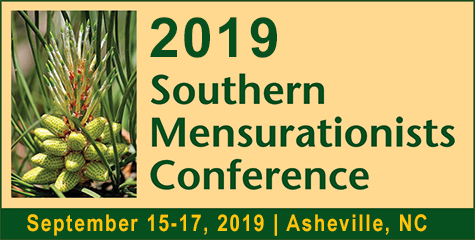2019 Southern Mensurationists Conference

Location: Asheville, NC
2019 SOMENS Onsite book (pdf)
Sunday, September 15
4:00pm-6:00pm – Registration at Hilton Garden Inn lobby
Monday, September 16
8:00am Coffee and pastries
8:15am Introductions and Welcome
Growth modeling – Moderator: C. Green
8:30am Estimating Parameters of the Weibull Function to Characterize Diameter Distributions – Quang Cao, Louisiana State University
8:50am Growth and yield models for hardwood and natural pines in the US South from 1920 to 2018 – Anil Koirala, University of Georgia
9:10am Modeling basal area growth after thinning – an alternative approach – Mauricio Zapata, University of Georgia
9:30am Coffee Break
Industrial application of biometrics – Moderator: C. Montes
10:00am Caveat emptor – How a forest analyst can help make informed decisions – Donald Gagliasso, MB&G
10:20am It’s time for standards in forest inventory – Zack Parisa, SilviaTerra
10:40am Integration of inventory, growth and yield, data management, and harvest planning in the Southeast US: Methods, Models, and Applications – Nate Herring, American Forest Management
11:00am Applications of a sampling simulator – Henry Rodman, SilviaTerra
11:20am Small area estimation in support of operational loblolly pine forest inventory – Corey Green, Virginia Tech
11:40am An industrial remote sensed inventory system – gaps and needs – Jim McCarter, Rayonier
12:00pm Lunch at the Pillar Room
Taper, weight and wood science – Moderator: S. Patton
1:00pm Modeling stem properties for eucalyptus in New Zealand – Dan Boczniewicz, University of Canterbury
1:20pm Robustness of taper equations with alternative definitions of validation data – Sheng-I Yang, Virginia Tech
1:40pm A stem volume-ratio, biomass conversion & expansion factor approach to generating national-scale inventory estimates – Phil Radtke, Virginia Tech
2:00pm Modeling taper of longleaf pine – Bronson Bullock, University of Georgia
2:200pm Estimating height from multiple diameters – Mark Porter, University of Georgia
2:40pm Coffee Break
Growth modeling – Moderator: C. Clark
3:10pm Long-term dynamics of loblolly pine crown structures – Dahai Zhao, University of Georgia
3:30pm Modeling height growth for teak plantations in Colombia – Sergio Orrego, Universidad Nacional de Colombia
3:50pm SStand survival projection as a function of age versus dominant height – Mingliang Wang, University of Georgia
4:10pm Poster session in hotel lobby
6:00pm-8:00pm Banquet at Pack Tavern’s Century Room
Tuesday, September 17
8:00am Recap from Monday – Holly Munro
Theoretical and philosophical topics – B. Bullock
8:10am A comparison of error distributions for estimation of stand survival – Mike Strub, Independent researcher
8:30am Thoughts on model selection – Harold Burkhart, Virginia Tech
8:50am The Sample Design: A Model or a Rule (that will be Broken) – Frank Roesch, US Forest Service
9:10am Linear feature in primeval forest as indications of anthropogenic heritage – Chris Cieszewski, University of Georgia
9:30am Coffee Break
Ecophysiological applications – Moderator: J. McCarter
9:50am Development of ecophysiological tools for managing Arauco plantations – Juan Quiroga, Arauco Holding
10:10am Temperature Thresholds for Growing Eucalyptus in South America – Túlio Queiroz, São Paulo State University
10:30am Temperature-based model for predicting pine beetle numbers – Holly Munro, University of Georgia
10:50am Modeling dominant height as a function of leaf area – Stephen Kinane, University of Georgia
11:10am Estimation of Eucalyptus stands productivity using efficient Artificial Neural Network – Ricardo Neto, Federal University of Viçosa
11:30am Two- and three-stage least squares for biomass estimation – Tom Lynch, Oklahoma State University
12:00pm Lunch at the Pillar Room
1:00pm Speaker awards ceremony – Moderator: S. Patton
1:30pm The Mike Stub Challenge – Moderator: M. Strub
1:45pm Final remarks – Moderator: N. Osborne
2:00pm Business Meeting – Moderator: B. Bullock
3:00pm Adjourn
Nate Osborne
Biometrics Project Leader, Rayonier
Bronson Bullock
Professor of Forest Biometrics and Quantitative Timber Management
Cristian Montes
Associate Professor of Natural Resource Biometrics
Mike Strub Challenge
Camp Daniel Boone Lake, less than 30 miles from Asheville NC as bird flies, satisfies the thirst of many elks and whitetail deer. Let's assume that there are no elks and deer drinking from the lake in the winter because it is frozen. Let's also assume that, after the ice on the lake melts, the elks and the whitetail deer arrive as independent Poisson processes, labeled E and D, with the intensities epsilon and delta, respectively. You are asked to find the probability of 1) an elk coming first to the lake, after the ice melts, and 2) exactly r whitetail deer will arrive between two consecutive elks arrivals.
Evaluation criteria (in order of importance):
- Correctness - the solution should be correct
- Completeness – the solution should contains all the necessary elements, namely definitions, assumptions, and theorems/lemmas used
- Simplicity – the solution should be short
SOMENS Achievement Award
"SOMENS Achievement Award" honors scientists that contributed significantly to quantitative southern forestry. The award aims at senior researchers that are associated with the Southern Mensurationists group and have shaped the forest research of/from the southern region of the USA. The award is given only once to an individual. Please cast your vote by clicking here.
